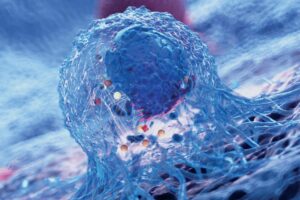What is already known
The gut microbiota not only contributes to the development of the immune system and aids digestion, it also protects host cells from pathogens — a process known as colonization resistance. Scientists have known that gastrointestinal infections can change the gut microbiota composition and disrupt colonization resistance, but it’s unclear how commensal bacteria adapt to gut infections.
What this research adds
Working in mice, researchers have found that populations of the commensal bacterium Bacteroides thetaiotaomicron are stable for weeks in the healthy gut. But during a mild infection, the microbe replaces most of its previous populations with the descendants of only a few cells. These founder cells carry a genetic variant that promotes resistance to antibacterial molecules made by the host during infection. The researchers also identified gut commensal species that reduce the selection of this genetic variant during infection.
Conclusions
The findings suggest that a mild gastrointestinal infection can alter gut commensal populations in ways that boost the commensal’s ability to proliferate during an infection.
Commensal bacteria have to adapt to the gut environment in healthy and diseased conditions. New research shows that a specific commensal microbe responds to gut infections by evolving inflammation-adapted variants.
The findings, published in Cell Host & Microbe, suggest that a mild gastrointestinal infection can alter gut commensal populations in ways that boost the commensal’s ability to proliferate during an infection.
Scientists have known that the gut microbiota not only contributes to the development of the immune system and aids digestion, it also protects host cells from pathogens — a process known as colonization resistance. Although gastrointestinal infections can change the gut microbiota composition and disrupt colonization resistance, it’s unclear how commensal bacteria adapt to gut infections.
To address this question, Andrew Goodman at Yale University School of Medicine and his colleagues analyzed the population dynamics of Bacteroides thetaiotaomicron — one common microbe found in the human gut microbiota — in mice infected with a gut pathogen.
Increased fitness
To measure B. thetaiotaomicron’s population dynamics inside the gut of a mouse, the researchers tagged the microbe’s genome with ‘barcodes’ — small snippets of DNA from a specific gene. Four days after having the barcoded B. thetaiotaomicron colonize germ-free mice, the researchers infected the animals with the gut pathogen Citrobacter rodentium.
In a healthy gut, the population of B. thetaiotaomicron was stable for weeks. But during a mild infection with C. rodentium, the commensal microbe replaced most of its previous population with the descendants of only a few cells, the researchers found.
These founder cells carry a genetic variant that promotes resistance to antibacterial molecules made by the host during infection, thus increasing the commensal’s fitness. Further experiments suggested that the changes in bacterial fitness are stable through multiple generations.
Infection mark
The researchers identified gut commensal species, including Bacteroides caccae and Bacteroides ovatus, that reduce the selection of the inflammation-adapted variant of B. thetaiotaomicron during infection. These species increase the levels of vitamin B6 in the gut, the team found.
Giving vitamin B6 to mice was sufficient to reduce variant expansion in infected animals. The researchers speculate that this vitamin may represent a molecular link between microbiota composition, diet and the population dynamics of commensal microbes during infection.
“Our work demonstrates that a self-limited enteric infection can leave a stable mark on resident commensal populations that increase fitness during infection,” the authors say.











